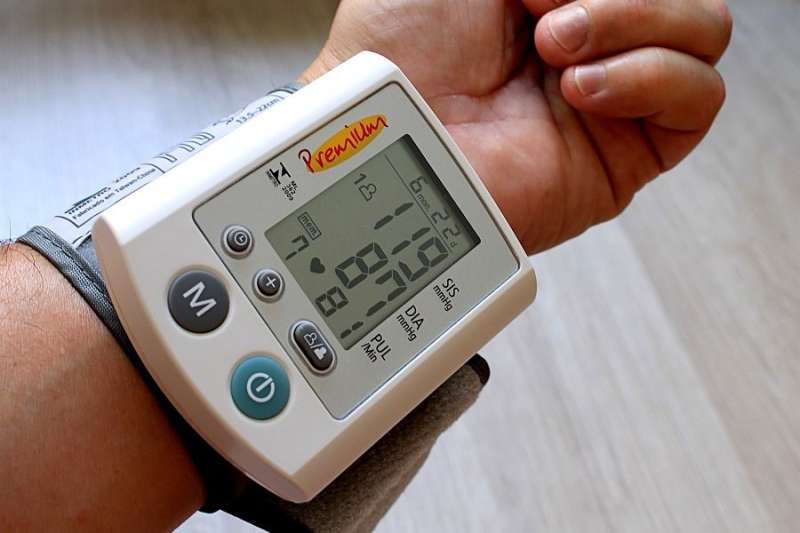Home-based blood pressure monitoring should be commonplace in NHS, say researchers

Researchers from the Universities of Birmingham, Oxford and Cambridge carried out a trial which showed that when GPs base their medication adjustments on regular blood pressure readings taken by patients at home, blood pressure is significantly lower after 12 months when compared with those who are managed exclusively in the clinic.
The findings of the National Institute for Health Research-funded trial were published today in The Lancet. Called the TASMINH4 trial, it involved more than 1,000 patients with poorly-controlled blood pressure who were recruited through 142 general practices in England.
Sometimes described as a 'silent killer', high blood pressure – also known as hypertension—affects more than one in four adults in England. While often preventable, it is a leading cause of cardiovascular disease and the biggest risk factor for death and disability internationally.
Long-term hypertension control involves regular blood pressure checks by a health professional so that medication can be adjusted accordingly, yet this can be a challenge to manage in primary care despite the wide availability of effective treatments.
Internationally, surveys have found up to 70 percent of people with hypertension self-monitor their blood pressure from home, yet in the UK this figure is much lower at around 30 percent. In the NHS, offering patients their own blood pressure monitor has been controversial due to contradictory evidence and concerns that patients can be anxious about self-monitoring.
Dr. James Hodgkinson, of the University of Birmingham's Institute of Applied Health Research, said: "The success in controlling blood pressure from the use of self-monitoring, and a lack of adverse events, suggests that the technology is now ripe for wider implementation in daily practice and in national and international guidance.
"With most general practitioners and many patients using self-monitoring, it could become the cornerstone of hypertension management in primary care."
Lead author Professor Richard McManus, an Oxfordshire GP and NIHR Professor of Primary Care at Oxford University's Nuffield Department of Primary Care Health Sciences, said: "We now have conclusive evidence that GPs can use the readings from patients who self-monitor their own blood pressure to achieve significantly lower blood pressure after 12 months compared with conventional approaches.
"This reduction in blood pressure comes with no additional workload for the GP, and the self-monitoring system is cheap and simple for patients to use. In the longer term, we predict that better blood pressure control could result in significant health benefits for the patient – a likely 20 percent reduction in stroke risk and 10 percent reduction in coronary heart disease risk.
"For faster, more efficient blood pressure reduction, using telemonitoring could be worthwhile for some patients. Enabling the patient to text their readings to their GPs and nurses, with alerts and feedback for both patients and GPs, could be particularly advantageous in today's NHS where doctors feel increasingly overwhelmed by the quantities of data they deal with on a daily basis."
In their randomised controlled trial, the researchers compared conventional clinical care for blood pressure management with two different forms of home monitoring, either: reporting blood pressure readings via post (known as self-monitoring) or by SMS text message (known as telemonitoring). Patients in the self-monitoring and telemonitoring groups were asked to monitor their own blood pressure twice each morning and evening for the first week of every month using an electronic blood pressure monitor, and report their readings back to the clinic.
After 12 months, systolic blood pressure was lower in both self-monitoring and telemonitoring groups (self-monitoring: 137.0mmHg; telemonitoring: 136.0mmHg) compared with usual care (140.4mmHg). Yet at just six months blood pressure became lower more quickly for those who used the telemonitoring system to report their readings (self-monitoring: 140.4mmHg; telemonitoring: 139.0mmHg; usual care: 142.5mmHg). The trial also found no evidence of increased anxiety in patients who self-monitored or telemonitored or any changes in weight, diet, exercise or alcohol consumption that could lead to the reductions in blood pressure observed.
The telemonitoring system automatically alerted patients if the reading was high, low or normal, along with SMS reminders to prompt patients to send their readings or contact the clinic if their average blood pressure meant their medication needed to be adjusted. GPs were able to access a digital 'dashboard', including graphical displays of blood pressure readings, and had the option to message their patients through the system. Those in the postal group only had access to a colour chart to decide whether to contact their clinic for medication adjustment.
Co-author Professor Jonathan Mant, of the University of Cambridge, said: "Sixteen million people in the UK have high blood pressure and should be offered the option of self-monitoring to control their hypertension.
"Those who find it particularly challenging to get to their GP due to work commitments would benefit from the telemonitoring system developed in this trial, which could be adapted into a readily-available smartphone app and incorporated into existing clinical patient record systems.
"We are currently looking at whether telemonitoring is cost-effective to warrant its inclusion in clinical guidelines."
The target blood pressure used by the trial was lower than previous self-monitoring trials to reflect evidence that blood pressure readings are lower at home than in the clinic.
More information: Efficacy of self-monitored blood pressure, with or without telemonitoring, for titration of antihypertensive medication (TASMINH4): An unmasked randomised controlled trial. McManus RJ, Mant J, Franssen M et al. The Lancet S0140–6736(18)30309-X www.thelancet.com/journals/lan … ulltext?elsca1=tlxpr. DOI: 10.1016/S0140-6736(18)30309-X

















